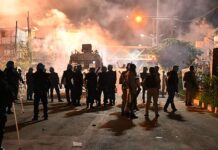M. Inamul Haque
THE Savar disaster on April 24 has engulfed the people of this country with both grief and panic. We are very much together with those who have lost their beloved ones in the disaster. We are panicked that this is not the end. There may be more forthcoming, and might be with more severity. Prime Minister Sheikh Hasina said on April 25 that 90% of our buildings have been constructed without following the building code.
Does it mean 90% of our buildings are unsafe? No, it does not mean that, but albeit, many of those 90% buildings are unsafe. The Rajdhani Unnayan Kartripakka (Rajuk) has the list of those buildings. We have to sort out the unsafe buildings on an urgent basis. Along with that, we shall have to take appropriate structural measures (if possible) to make them safe, otherwise, demolish them to prevent disaster.
It is true that the construction and garments sectors are contributing to the growth of the economy tremendously. But the construction industry is run with bribes, illegal occupation, extortion etc., in purchasing or possessing land, approval of design, obtaining bank loans, procurement of construction materials and in the work execution. As a result, many of the posh buildings resound with the cries of the cheated people, and residents live with the fear of collapse.
In Bangladesh, ownership of a piece of land is either through inheritance, or by purchase, or by occupation, or through power of attorney; but occupation plays the only effective role. The occupier may not be the real owner, but grabs not only the land, but also the public land in the vicinity. No law, no law enforcing agency or public anger can deter them from such acts. Thus, the culprits are reigning all over the country, with blessings from their political masters.
It is known that most of the buildings are constructed beyond their approved design, but no punishment has ever been imposed on the perpetrators. Rajuk has filed a case against the Rana Plaza owner for violating building codes, but why did it not do so before the disaster?
A building has two major parts, substructure (below the plinth level) and the superstructure. Whatever may be the size of the building, it should stand on a stable foundation. If the building has organic or filled up soil beneath, it should have dug-in piles to obtain enough load bearing capacity by skin friction. In and around Dhaka city, we have Pleistocene Age hard soil at many places, but we have filled organic soil in the lowlands and ponds.
A large structure anywhere should rise from the bottom of the piles considering (1) Dead Load of the full structure to be built, (2) Live Load of the movable equipment, furniture, fittings and the users and (3) Vibration Load due operation of equipments, movement of people etc. Nowadays, Earthquake Load is also added to design a safe structure. Nonetheless, the construction materials used play a vital role in the stability of the building. For added security, an engineer imposes two to three times factor of safety in designing the structures.
The Rana Plaza in Savar was 10 stories high, more than the approved design of 5 stories. We can say that the building collapsed because (1) the design was given without any factor of safety, or (2) the load imposed over 5 stories exceeded the factor of safety, or (3) poor materials or less materials were used in the construction, or (4) the live load was more than estimated or had heavier duty operations, or (5) the foundation was laid on poor soil beneath or not stood on sufficient number of piles.
It is reported that there was heavy extra load on the rooftop and electricity generators on every floor. On the day of the event, there was load shedding in the area, and when the generators started the building collapsed within seconds. However, this did not happen all on sudden. Before the disastrous event, the building authorities had noticed some cracks in the columns of the structure, but ignored it.
Enough should be enough by now. For the last 42 years we have not seen any political government rise above party interest to work for the people. Today’s anarchy, in every public sector, is the result of that. I hope the concern raised by the prime minister will create a new wave in our society. Now the time has come to wake up and work together, to make our homes safe for ourselves and our children.
The writer is Chairman, Institute of Water & Environment.
Email: minamul@gmail.com
Source: The Daily Star










